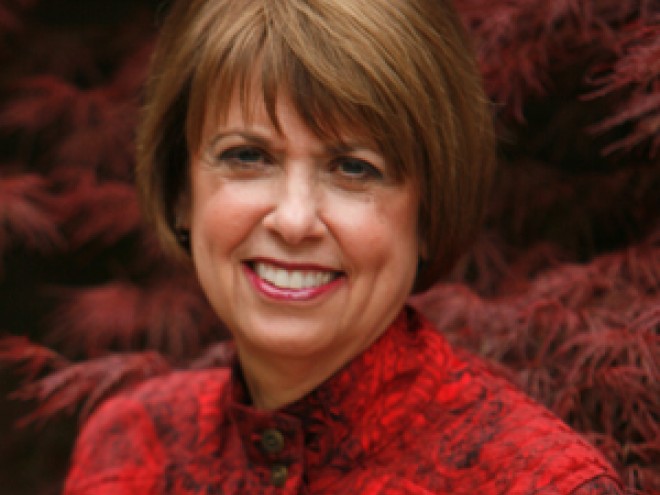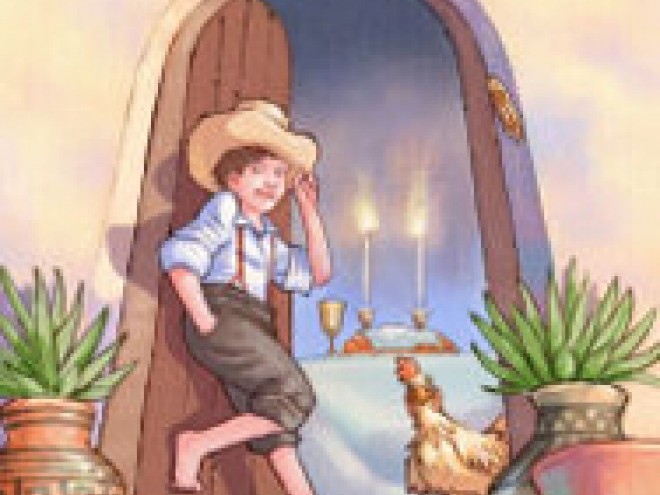Jewish Book Council’s Michal Hoschander Malen speaks with children’s author Yaffa Ganz from her home in Israel.
 Michal Hoschander Malen: Yaffa, you have educated and entertained generations of Jewish children. In my own family, for example, my daughter adored the Savta Simcha books and now my seven-year-old granddaughter is loving them, as well. What do you think accounts for the longevity of the appeal of your characters?
Michal Hoschander Malen: Yaffa, you have educated and entertained generations of Jewish children. In my own family, for example, my daughter adored the Savta Simcha books and now my seven-year-old granddaughter is loving them, as well. What do you think accounts for the longevity of the appeal of your characters?
Yaffa Ganz: What accounts for the appeal of any happy, helpful, friendly person? Maybe that’s the answer! Savta Simcha and Uncle Nechemya are happy, warm, friendly, good people who want everyone else to be happy as well. These are the kind of people who make the world go round; the kind of people we all love, whether they lived a hundred years ago or yesterday. They don’t go out of style.
MHM: In addition to such memorable characters, two themes stand out in your children’s stories: joy in the celebration of Shabbat and holidays and a passionate love of the land of Israel. How do you transmit these concepts, which are clearly so precious to you, so vibrantly through the pages of your books?
YG: Judaism and Torah are all about love and simcha. Love for G‑d and His Torah, His People and His Land. And simcha, which is not synonymous with “happiness.” Simcha is the joy of living in what we might call a “G‑dly dimension.” It’s the joy of striving for Truth and eternal values, doing G‑d’s Will and being a mensch. So if you’re really into being Jewish, simcha comes with the territory!
MHM: I think there’s a third theme that I should have included above because it permeates all of your stories — kindness and thoughtfulness between people. Please tell us a bit about how and why that concept remains a constant throughout, no matter the plot, no matter the setting.
YG: There are two very basic concepts which guide the life of a Jew— recognizing that all people were created in the image of G‑d and to show our gratitude for all the good we receive. A Jew is commanded to treat all human beings with courtesy, generosity and respect and to have a special, loving relationship with his fellow Jews. And he must show gratitude to G‑d and to everyone else who helps supply his needs. Without our fellow human beings, we couldn’t possibly survive. And if we do not bother to acknowledge our debts to people, we won’t acknowledge our debts to G‑d either. So kindness and thoughtfulness and sensitivity are very deeply embedded Jewish concepts. Besides, who wants to live in a world where people are nasty and selfish and mean?
MHM: Your Jewish history book Sand and Stars is fascinating and comprehensive. What kind of research did that entail?
YG: Jewish kids, even those who go to day schools, have very poor historical cognition. For all they know, the Maccabim and George Washington lived in the same year! I wanted to write a Jewish history which would be easy, interesting reading; something which would portray not only the unspeakable suffering we have endured, but the grandeur, the faithfulness, the exceptional message and contribution of the Jewish people to the world. Writing the Jewish history was the easy part; connecting it to the general history of the world without getting lost in the details was the hard part. The Jews interacted with and influenced the world. And the world most definitely left its mark on us.
Rabbi Berel Wein’s history books served as an outline, supplemented by a large selection of other history books — both Jewish and general. I tried to make this a personal story of our people, and I included material younger readers would find interesting. I also used Jewish sources wherever possible — the Talmud, the midrashim, the commentaries. We added maps and time-lines for visual clarity so it would be easy to follow. Mostly, I wanted it to read like a good story. It took a year of intensive work and although it’s not a detailed, comprehensive history, it does takes the reader on a fascinating, two thousand year journey through the mainstream of Jewish history.
MHM: In addition to children’s books, you’ve written books of essays for adults. Have you ever considered writing a fiction book for adults, as well?
YG: Considered it? Yes. Done it? No. At least not yet! However, you can find a good dose of fiction in my books of essays. Cinnamon and Myrrh was recently reprinted by Feldheim. It takes a look at our contemporary Jewish lifestyle, pokes fun at many of our quirks and foibles, and offers a few wise gems to ponder as we plod along the path of life.
MHM: You moved from the United States to Israel in the 1960s. Can you give our readers a small taste of your daily life there?
YG: The “taste” of life in Israel is delicious, aggravating, trying, exhilarating, exciting, worrying, fulfilling and wonderful! There is nothing like it anywhere else on the globe. Now that I am finally a Liberated Lady (any female can be a liberated Woman. Being a Lady is an additional badge of honor!) I have more time to do what women and ladies dream about doing — study, read, play the flute, and write whatever I am working on at the moment, enjoy my friends and family and especially my delicious grandchildren and great grandchildren. Each one is a blessing. And since each new family addition necessitates a dedication in a new book, I have to keep writing. My grandchildren are very insistent that each one is mentioned in a book of his or her own.
MHM: It’s wonderful news that some of your classics are being reissued now. Is there any chance that we can also look forward to anything new in the near future?
YG: One new book—All Kinds of Kids—was published around six months ago. And two favorite oldies—The Adventures of Jeremy Levi and Hello Heddy Levi just came out this week after a long interval. Feldheim has recently reprinted all four Mimmy Simmy books and the five Savta Simchas are back on the shelves with new covers. All of these books were out of print for several years. Dr. Mitzva is planned to reappear again along with a second, new Dr. Mitzva book before the summer (he’s the great Doctor of Mostly Everything!).
As far as new ideas, I have a large collection of poetry I’d love to put out. Unfortunately, most publishers are not interested in poetry. Can it be that only the poets read poetry?
Aside from that, I would like to see the rest of the Savta Simcha series translated into Hebrew. Believe it or not, not a single one of my many grandchildren has read any of my books in English unless it was a school assignment (which takes all the joy out of the reading). Savta Simcha exists in French and German and one volume is in Spanish, but only three of the five books have appeared in Hebrew. I’m working on it now. Wish me luck.
MHM: Thank you for so much storytelling pleasure over so many years and for sharing part of your own story with us.
YG: And thank you for asking! Giving pleasure to so many readers is a source of great pleasure for me. And knowing that a third generation is reading the books is absolutely lovely!

Michal Hoschander Malen is a librarian and editor of reference books. She is the children’s and young adult section editor of Jewish Book World.
Related Content:
- Four in One! Four Favorites by Yaffa Ganz
- Browse JBC Interviews
- Children’s: Recent Reviews
Michal Hoschander Malen is the editor of Jewish Book Council’s young adult and children’s book reviews. A former librarian, she has lectured on topics relating to literacy, run book clubs, and loves to read aloud to her grandchildren.



